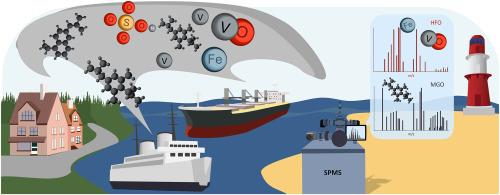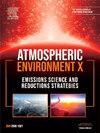使用单粒子质谱仪检测和分析船舶排放物:德国罗斯托克港陆地实地研究
IF 3.4
Q2 ENVIRONMENTAL SCIENCES
引用次数: 0
摘要
由于船舶排放对全球空气质量,特别是沿海地区的空气质量有重大影响,因此对船舶排放的监管变得更加严格。根据国际海事组织(IMO)的规定,目前的限制主要是将燃料中的硫含量分别限制在 0.5 % 和 0.1 %。根据这些规定,废气二氧化硫净化系统(洗涤器)和新型低硫燃料的使用越来越多。为了全面监测船舶排放,需要采用先进的测量技术。我们的研究报告介绍了在德国罗斯托克港进行的陆基现场活动的结果。我们选择的测量地点具有战略意义,可以捕捉到 2 公里范围内所有进出港船只。通过光学颗粒测定仪(OPS)和扫描迁移率颗粒测定仪(SMPS)监测颗粒数量和粒度分布的快速变化,显示潜在的船舶废气羽流。此外,还利用单颗粒质谱仪(SPMS)通过化学特征对环境中的单颗粒(0.2-2.5 μm)进行定性分析。在一周的时间内,共确定了 73 艘船舶的废气羽流。SPMS 对单个颗粒中的过渡金属和多环芳烃(PAH)具有高灵敏度,因此可以区分不同的海洋燃料。本文章由计算机程序翻译,如有差异,请以英文原文为准。

Detection and analysis of ship emissions using single-particle mass spectrometry: A land-based field study in the port of rostock, Germany
The regulation of ship emissions has become more restrictive due to their significant impact on global air quality, particularly in coastal regions. According to the International Maritime Organization (IMO) regulations, current restrictions mainly limit the sulfur content of the fuel mass to 0.5 % and 0.1 % respectively. In compliance with these regulations, exhaust SO2 cleaning systems (scrubbers) and new low-sulfur fuels are increasingly used. For comprehensive monitoring of ship emissions, advanced measurement techniques are demanded. Our study reports on the results of a land-based field campaign conducted in the port of Rostock, Germany. The chosen location strategically positions the measurement setup to capture all incoming and outgoing ships passing within a distance of up to 2 km. Potential ship exhaust plumes are indicated by rapid changes in particle number and size distribution monitored by an optical particle sizer (OPS) and a scanning mobility particle sizer (SMPS). Additionally, single-particle mass spectrometry (SPMS) was used to qualitatively characterize ambient single-particles (0.2–2.5 μm) by their chemical signatures. In a one-week time span, the exhaust plumes of 73 ships were identified. The high sensitivity of SPMS to transition metals and polycyclic aromatic hydrocarbons (PAH) in individual particles make it possible to distinguish between different marine fuels.
求助全文
通过发布文献求助,成功后即可免费获取论文全文。
去求助
来源期刊

Atmospheric Environment: X
Environmental Science-Environmental Science (all)
CiteScore
8.00
自引率
0.00%
发文量
47
审稿时长
12 weeks
 求助内容:
求助内容: 应助结果提醒方式:
应助结果提醒方式:


